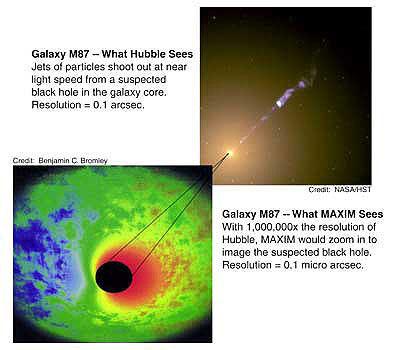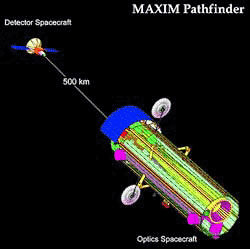|

NASA-GSFC NEWS
RELEASE
Posted: September 18, 2000
|
|
An illustration of a supermassive black hole
at the center of a galaxy.
Photo: NASA
Scientists have
designed and successfully tested a new type of X-ray telescope
that, when fully developed and placed in orbit, may capture the
first images of a black hole and resolve details of nearby stars
as clearly as we see our own Sun today. The report is published
in the September 14 issue of Nature.
The X-ray telescope
designed by University of Colorado and NASA has the potential of
providing resolution a thousand times sharper than the finest
images available today in any wavelength and a million times
better than what current X-ray telescopes can muster.
In orbit,
such an instrument could resolve a region the size of a dinner
plate on the surface of the Sun. The telescope employs a
technique called interferometry, a process of coupling two or
more telescopes together to synthetically build an aperture
equal to the separation of the telescopes. |
 |
"Through the power of ultra-high resolution, we could journey to
distant places without need for a warp drive," said Dr.
Webster Cash, a professor at University of Colorado and lead author on the
Nature article. "This new approach allows X-ray astronomers to
essentially jump from telescopes with resolution no finer than what
an amateur uses in the backyard to an observatory far more precise
than Hubble."
|
Comparing
Hubble data design concept for the MAXIM Pathfinder.
Photo: NASA
X-ray telescopes are
essential for studying black holes up close, said Dr. Cash,
because the X-ray band is the dominant radiation in the region
directly surrounding these strange objects.
X rays can also
travel through the dusty Milky Way galaxy in ways that optical
light cannot. X-ray telescopes must be placed in orbit, for
celestial X rays do not penetrate the Earth's atmosphere.
To see Multimedia in

"The Universe
through the Hubble"
(file 3.4 Mega / 2-3
minutes to load)
"click"
HERE |
 |
Dr.
Cash and his colleagues have achieved 100 milliarcsecond
resolution (similar to Hubble) in the laboratory with their X-ray
interferometer. This is a five-fold improvement over the best
conventional X-ray telescopes, which achieve 500 milliarcsecond
resolution.
This interferometry design is currently under study at Goddard Space
Flight Center in Greenbelt, Md., for two proposed NASA missions with
the ultimate goal of imaging a black hole. MAXIM, the Microarcsecond
X-ray Imaging Mission, could achieve 100-nanoarcsecond resolution
and would entail a fleet of spacecraft with separate optics flying
in precise formation.
The MAXIM Pathfinder would be a smaller
mission with all the X-ray optics on one spacecraft, achieving
100-microarcsecond resolution. These interferometers would
complement, not replace, large area X-ray telescopes also planned
for the future.
With 100 microarcsecond resolution, astronomers could image the
coronae of nearby stars, seeing the actual disks of other stars
which appear now only as points of light. With 100 nanoarcsecond
resolution, astronomers could attain one of astronomy's ultimate
goals -- imaging a black hole. (It is a thousand-fold increase in
each jump from "milli" to "micro" to "nano".)
"Black holes hold an almost mythical attraction," said
Dr. Nicholas White, head of Goddard's Laboratory for High Energy Astrophysics.
"Compelling evidence that black holes exist has come from
observations of their gravitational effect on nearby objects, but
the ultimate proof is yet to come -- a direct image of the 'black
dot'. The X-ray interferometer may take us there."
|
Preliminary design concept for the MAXIM Pathfinder.
Photo: NASA
Interferometry is a common practice in radio astronomy (e.g. the
Very Large Baseline Array) and an emerging technique for optical
astronomers (e.g. the Keck Observatory).
The technique is
similar to the way sound waves can be combined to either cancel
each other out (resulting in silence) or amplify the sound.
NASA's first orbiting optical interferometer, called the Space Interferometry Mission, is scheduled for launch in 2006.
The Chandra X-ray Observatory, NASA's most powerful X-ray
telescope to date, has generated a multitude of major
astronomical discoveries in the 15 months since its launch.
|
 |
Chandra achieves its unprecedented 500 milliarcsecond resolution not
through interferometry but rather through highly polished and
carefully aligned mirrors.
Joining Dr. Cash on the Nature article are Drs. Ann Shipley and
Steve Osterman, both at University of Colorado, and Dr. Marshall Joy of
NASA's Marshall Space Flight Center in Huntsville, Ala. Testing of
the prototype X-ray interferometer took place at NASA-Marshall in
1999.
The proposed MAXIM and Pathfinder missions would launch after 2010.
|